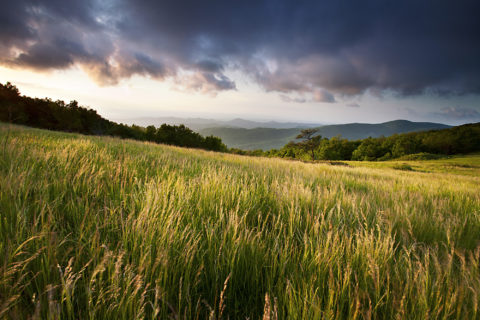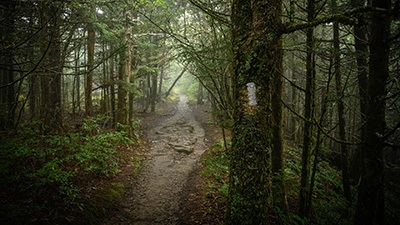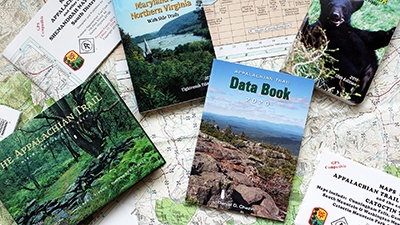By Alyson Browett
This Tiny Beetle is Killing the Appalachian Trail’s Ash Trees
November 15, 2018
A killer is roaming America’s eastern forests. The menace: the emerald ash borer, or EAB, a small metallic-green beetle accidentally imported from Asia in the 1990s that is decimating North American species of ash trees.
 Image courtesy of the University of Maine
Image courtesy of the University of Maine
Now detected in 32 states, including 12 of the 14 states along the Appalachian Trail (A.T.) corridor, the beetles effectively strangle and kill trees within four years of infestation. With a kill rate of 99 percent, the emerald ash borer is the most destructive forest insect to ever invade the U.S.
In Southeastern states, ash trees make up 3-5 percent of the forest. The trees grow tall and straight with their thick, leafy canopies shading the forest floor, roadways and urban landscapes. Ash wood is a valuable resource for making furniture, flooring, baseball bats, guitars and much more.
Many animal species depend on the trees for survival, for food and habitat. But as EAB continues to kill ash, animals ranging from butterflies to bobwhites to beavers face a risk of extinction or extirpation (extinction in a specific geographic area). The death of ash tree populations will permanently change our forests, and if nothing is done, every single ash tree will eventually die.
To state the obvious: the emerald ash borer is BAD.
Facing the Challenge
Fortunately, the Appalachian Trail Conservancy (ATC) is taking on this huge challenge. The ATC is fighting against EAB along with many partners, including the U.S. Forest Service (USFS); MountainTrue, a North Carolina-based environmental organization that works to champion clean water and resilient forests; and a legion of dedicated A.T. volunteers. Through an EAB working group and MountainTrue’s Save Our Ashes campaign, the groups are focused on monitoring and protecting ash trees along the A.T. corridor.
 ATC staff and members of its Conservation Leadership Corps treat trees to prevent EAB infestation. Each treatment provides three years of protection.
ATC staff and members of its Conservation Leadership Corps treat trees to prevent EAB infestation. Each treatment provides three years of protection.
While there is no way to save trees that have already been infested, treating trees before they are affected has shown promise. The use of emamectin benzoate, a systemic pesticide derived from a naturally-occurring soil bacterium, provides ash trees with three years of protection. Also, the USDA Animal Plant Health Inspection Service (APHIS) is investigating several species of wasps as possible methods of controlling EAB populations, which hunt down and devour EAB and their larvae. USFS has deployed three of these species on the A.T. in two Tennessee locations.
“Protection of trees that haven’t yet been infested will not save the forests from EAB, but this protection will keep seed trees alive while the next steps are determined,” said Matt Drury, ATC’s resource management coordinator for the Southern Region. “Treatment also helps protect seed trees and preserve the localized genetics of these trees that have lived and evolved for more than 10,000 years.”
A Race Against Time
A huge challenge is finding stands of ash trees that are not yet infested or too far gone to treat, according to Drury. “Our biggest success is being able to take action in the nick of time,” he said.
Last year, the ATC was able to treat 200 trees that were in good shape in the Pisgah National Forest, the area south of Max Patch and on Bluff Mountain. However, the ATC was not able to treat trees in Tennessee last year — as a result, there were fewer eligible trees when treatment began this year.
Drury said one goal for 2019 is to gain permission from the USFS through the National Environmental Policy Act (NEPA) to treat trees in Georgia, which is infested by EAB in some areas but still has trees that can be saved. To do that, the ATC will partner with Georgia National Forests, Georgia Forest Watch, and the Georgia Appalachian Trail Club. Another goal is to identify and treat more eligible ash trees in Tennessee and North Carolina along the southern A.T. corridor.
“I know there are beautiful ash stands out there we haven’t found yet,” Drury said. “When we do find them, we still don’t have the necessary financial resources to treat them all. Leaving trees behind is disappointing.”
The Need for Money and Manpower… and How You Can Help
Staying ahead of EAB through the monitoring of trees is one challenge, but finding the manpower and money to conduct treatments is another. The ATC and MountainTrue continue to recruit volunteers to help identify and treat ash trees along the A.T. corridor in North Carolina and Tennessee, and volunteers likely will be needed in Georgia next year.
 Ash trees make up 3-5 percent of all the trees surrounding the Southeast sections of the Appalachian Trail. Losing them to EAB would drastically impact the Trail’s ecosystems.
Ash trees make up 3-5 percent of all the trees surrounding the Southeast sections of the Appalachian Trail. Losing them to EAB would drastically impact the Trail’s ecosystems.
In 2018, the Appalachian National Scenic Trail unit of the National Park Service provided $30,000 to the ATC for the treatment of 536 trees at five sites along the Trail in the Nantahala, Pisgah and Cherokee National Forests. In addition to federal funding, the ATC used approximately $2,000 from the North Carolina A.T. license plate grant fund and provided $5,000 in license plate funds to MountainTrue to help treat trees. In 2017, an additional $10,000 was used from the grant fund to treat 200 trees in North Carolina.
“It will require significant investment to save even 1,000 trees,” said Josh Kelly, public lands field biologist at MountainTrue. “Public and private investment will be needed to save these trees.”
In addition to volunteering time and donating, the public can help control the spread of EAB by not transporting ash wood and using only treated kiln-dried wood. This helps control the spread of EAB and many other pests.
If you would like to volunteer to help save ash trees, contact Matt Drury at mdrury@appalachiantrail.org. To donate to help save the Trail’s ash trees and support our A.T. protection programs, visit donate.appalachiantrail.org.
Discover More

Appalachian Trail Conservancy
Our Work
Learn more about the Appalachian Trail Conservancy and the many roles it has in maintaining and protecting the Appalachian Trail.

ATC's Official Blog
A.T. Footpath
Learn more about ATC's work and the community of dreamers and doers protecting and celebrating the Appalachian Trail.





